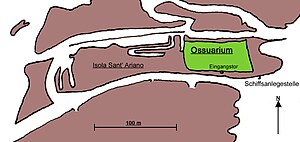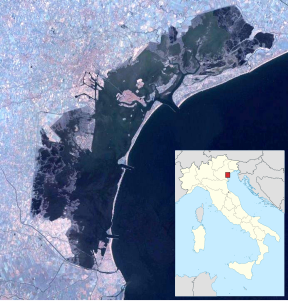Sant'Ariano
| Sant'Ariano | ||
|---|---|---|
| The island of Sant'Ariano with the ossuary | ||
| Waters | Venice lagoon | |
| Geographical location | 45 ° 30 '11 " N , 12 ° 26' 15" E | |
|
|
||
| length | 305 m | |
| width | 62 m | |
| surface | 2.57 hectares | |
| Residents | uninhabited | |
Sant'Ariano is an island in the lagoon of Venice , about 2.6 hectares in size, stretching from west to east . It is located northeast of the Venetian islands of Murano and Torcello in the laguna morta , the northern part of the Venice lagoon where the tides are no longer noticeable.
history
The island was first settled around the year 500 by residents of the Roman city of Altino , who probably also settled the island of Mazzorbo at the same time .
The Sant'Adriano monastery was built on the island around 1160 , and it also had a church . At that time there were bridges to the neighboring island. Originally Sant'Ariano belonged to Costanziaca.
The decline of the monastery and church began around 1400. In 1439 the last nuns left the island and moved to another monastery. The trigger was probably the considerable environmental, supply and accessibility problems caused by the rising sea level. In 1510 remains of the church were reported.
In 1565, the Senate of Venice approved a proposal by the health authorities to build a wall on the island and to set up an ossuary to accommodate exhumed corpses , to relieve the numerous small cemeteries of Venice ("campielli dei morti") and to "wild burial" under the pavement of the Prevent alleys. On a drawing by Thomasso Scalfurotto from 1779, the bones deposit with a small church behind the wall can be seen. From the end of the 17th to the beginning of the 18th century, some bones are said to have been picked up for use in sugar refining .
In 1837 the cemetery on San Michele was established as the central cemetery for Venice.
In the summer of 1998, the Italian radio amateur Paolo Toscano operated a one-time radio station on the south bank of the island as part of a competition.
The condition of the entire facility was very poor in 1999. The location of the old building was no longer verifiable.
According to reports, the ossuary is now overgrown with blackberry bushes and is not accessible. The human remains are said to be piled meters high.
Buildings
- A jetty is at 45 ° 30 '09.38 "N, 012 ° 26' 17.71" E.
- An approx. Two meter high wall encompasses the approx. 100 x 70 meter large area of the ossuary.
- There is a gatehouse on the south side of the wall, approx. 50 m west of the pier. The entrance gate, originally made of wood, has not existed since at least 1998; the opening was walled up.
- There are two smaller buildings on the island, including a badly damaged, partially ruined chapel.
In the west, north and east of the island, structures can be seen that appear artificially created by their characteristics and are reminiscent of port facilities.
Web links and sources
Individual evidence
- ↑ Venice islands: All the islands of Venice by area ( Memento of March 24, 2009 in the Internet Archive )
- ^ Islands of the Venetian Lagoon , ISBN 978-88-89922-02-6


